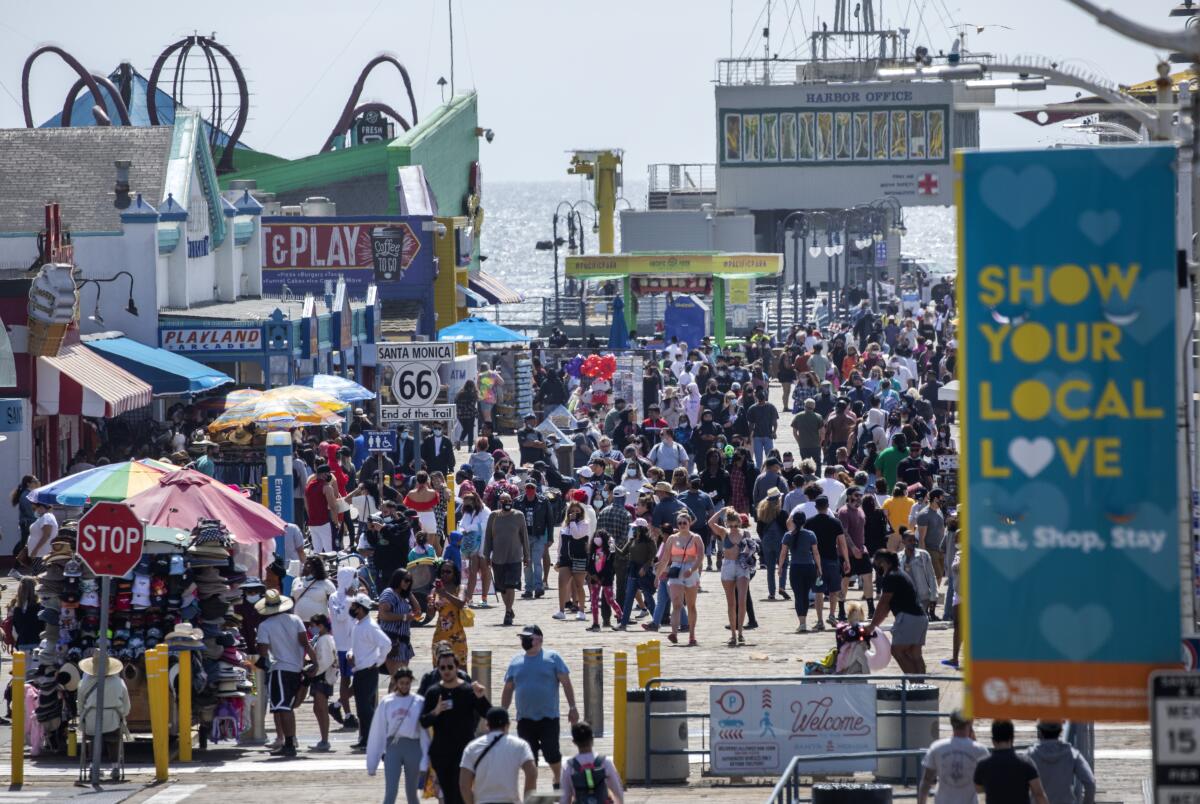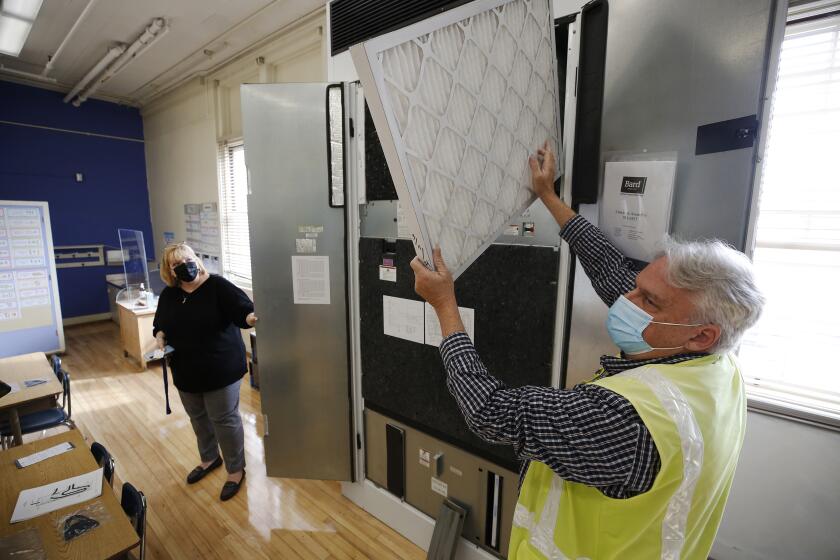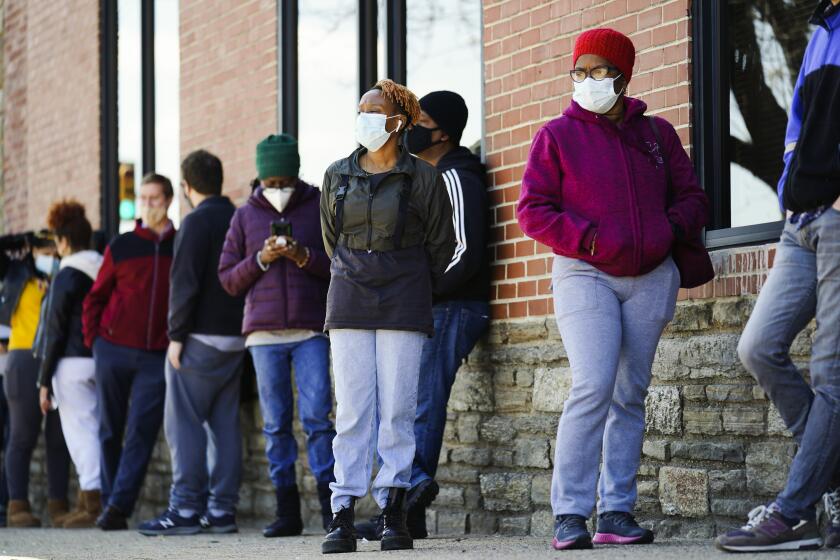California could actually reopen fully by June 15. Here’s what has to happen

- Share via
Can California really fully reopen its economy by June 15?
That’s the target date officials unveiled this week amid continued optimism regarding the statewide landscape of the pandemic as the number of new COVID-19 cases continues to fall and more people are getting vaccinated.
“With the expectation of an abundance of doses coming in from the federal government through the end of this month and into May, we can confidently say by June 15 that we can start to open up as business as usual — subject to ongoing mask wearing and ongoing vigilance,” Gov. Gavin Newsom said Tuesday.
County officials say moving to a less restrictive category in California’s reopening blueprint is a hard-fought gain in the battle against COVID-19.
Newsom said the goal is to get “back to a sense of normalcy.” But it will be a new normal.
Notably, California’s mask mandate will remain in place for the foreseeable future.
As has often been the case throughout the pandemic, the timeline is subject to change — and dependent on sustaining the state’s progress in the fight against COVID-19.
Here are four factors to consider.
California aims for a full reopening on June 15, depending on a sufficient vaccine supply and a stable, low hospitalization rate, and masks.
1. Vaccine rollout
The full reopening in contingent on a lot more people being vaccinated in California.
That’s hardly a new goal, but, officials say, it appears more achievable than ever.
This week, California received 2.4 million total vaccine doses, a 33% increase from two weeks ago, Newsom said.
And there’s hope those shipments will get even more robust in the weeks ahead. State officials previously estimated supplies could swell to more than 3 million doses a week in the second half of this month.
Those stepped-up deliveries would come just as California opens statewide vaccine access to anyone 16 and older on April 15.
However, circumstances are such that some counties — including Riverside, San Bernardino and Kern — have already thrown the doors open to everyone in that age range.
To date, providers throughout California have doled out nearly 20.5 million total COVID-19 vaccine doses, and 34.5% of residents have received at least one shot, according to data from the U.S. Centers for Disease Control and Prevention.
The timeline in California reflects growing national confidence that the tipping point between scarcity and surplus of vaccine supply may be just around the corner.
President Biden had initially said states should make all adults eligible for COVID-19 vaccines by May 1. But on Tuesday he announced a more aggressive deadline of April 19.
The vaccination site for the young from Los Angeles County is a Cal State Bakersfield facility that has more doses than patients and no restrictions.
Part of the reason June 15 was chosen as California’s target date was that it falls two months after the state will have extended vaccine eligibility to all adults, according to Dr. Mark Ghaly, the state’s Health and Human Services secretary.
“We wanted to be able to provide at least a couple of weeks, two to three weeks, for individuals interested in getting vaccinated who suddenly become eligible on April 15 to get in line to get their vaccines started,” he said.
The timetable for full vaccination depends on what type of shot is administered. Ghaly noted that the longest time frame is associated with the Moderna vaccine — which has a four-week gap between its first and second doses.
Health officials consider someone to be fully vaccinated two weeks after they receive their final dose.
2. COVID-19 trends
So far, California has bucked the spring COVID-19 rise seen in other parts of the nation.
And hospitalizations — another data point the state is tracking closely — have continued to go down.
Ghaly emphasized that, “if we see any concerning rise in our hospitalizations, we will take the necessary precautions. But right now, we are hopeful in what we’re seeing as we continue to build on the 20 million vaccines already administered.”
However, the state did not establish any hard benchmarks to determine whether it is ready to progress as hoped.
“We don’t have a specific number, per se, on the hospitalizations, but are looking at impacts on hospital capacity and the delivery systems’ ability to continue to deliver routine care,” Ghaly said.
New state guidance indicates that all K-12 schools should be offering full-time, five-days-a-week, in-person classes for the fall. Gov. Newsom stopped short Tuesday of saying it would be a mandate.
3. Variants
Health officials continue to warn that variants of the coronavirus — some of which have been shown to be more infectious — remain a threat.
Of particular concern is the U.K. variant, the most prevalent one detected in the United States, responsible for more than 15,000 cases reported in all 50 states, the District of Columbia and Puerto Rico.
The South African variant has been detected in more than 300 cases, and the Brazilian P.1 variant has been identified in more than 200 cases. Neither of those variants has been detected in every state.
In California, the two most dominant variants are the California and U.K. variants. The California Department of Public Health has recorded more than 9,000 cases of the California variant and 851 of the U.K. variant, which is more transmissible and possibly more deadly than the conventional strain
There have been 35 cases of the Brazilian P.1 variant, 33 cases of the New York B.1.526 variant, 22 cases of the Brazilian P.2 variant and 10 cases of the South African variant.
In Los Angeles County, the South African, U.K. and Brazilian variants have been detected, but none of them is dominating the area.
The existence of a coronavirus variant containing two worrisome mutations, first discovered in India two weeks ago, is confirmed in California.
A possibly worrisome variant of the coronavirus first identified in India has also been found in California, officials said this week.
This “double mutant” variant is sparking concern among some scientists because it contains not just one, but two mutations in its genetic composition that have been identified among other variants of concern being tracked by the CDC.
4. Behavior
California has already been reopening rapidly as COVID-19 fades. And that is bringing more crowds and concerns.
While many of those who are out and about may have already been vaccinated, health officials and experts continue to urge residents to remain vigilant and do their part to tamp down transmission of the virus — particularly as other states report new surges.
The heavy concentration of new coronavirus cases in just five states is putting pressure on the government to consider adjusting vaccine distribution.
Officials in L.A. County, for instance, continue to take a cautiously optimistic approach.
While the coronavirus case rate has dropped to a level not seen since the early days of the pandemic, Public Health Director Barbara Ferrer said that still “means that there are hundreds and hundreds of known cases that get diagnosed each day,” and the actual number of people being infected is likely higher.
Federal officials noting rising case counts elsewhere in the country on Monday said this is not the moment to return to normality.
“As community businesses begin to reopen, these findings underscore the vast impact of a single event affecting communities, schools, families and fragile elderly,” Dr. Rochelle Walensky, the CDC director, told reporters in a briefing. “And it emphasizes the impressive transmissibility of this virus and the continued need for … reducing the number of people indoors, improving building ventilation, and utilizing outdoor spaces as the weather allows.”
More to Read
Sign up for Essential California
The most important California stories and recommendations in your inbox every morning.
You may occasionally receive promotional content from the Los Angeles Times.
















